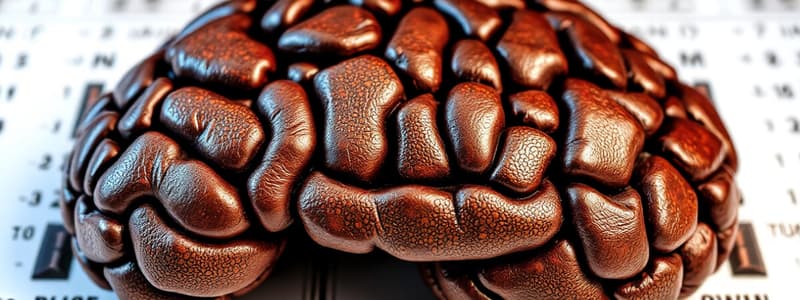Podcast
Questions and Answers
What primary role does the Central Executive play in Baddeley's model of working memory?
What primary role does the Central Executive play in Baddeley's model of working memory?
- Directing attention and coordinating cognitive processes (correct)
- Maintaining auditory information through repetition
- Storing visual information
- Processing long-term memory directly
Which method of encoding long-term memories involves associating information with personal experiences?
Which method of encoding long-term memories involves associating information with personal experiences?
- Elaborate Rehearsal
- Self-Reference Effect (correct)
- Maintenance Rehearsal
- Visual Imagery
How does the capacity of long-term memory compare to that of working memory?
How does the capacity of long-term memory compare to that of working memory?
- Long-term memory has a much smaller capacity
- Long-term memory has virtually limitless capacity (correct)
- Working memory has a virtually limitless capacity
- Both have the same capacity
What is the process by which unstable short-term memories become stable long-term memories?
What is the process by which unstable short-term memories become stable long-term memories?
Which component of working memory is specifically responsible for handling auditory stimuli?
Which component of working memory is specifically responsible for handling auditory stimuli?
What is the primary characteristic of working memory as defined in Baddeley's model?
What is the primary characteristic of working memory as defined in Baddeley's model?
Which of the following best describes the concept of 'chunking' in memory capacity?
Which of the following best describes the concept of 'chunking' in memory capacity?
According to George Miller, what is the approximate capacity of short-term memory?
According to George Miller, what is the approximate capacity of short-term memory?
What implication does current research suggest regarding the capacity of short-term memory when chunking is not utilized?
What implication does current research suggest regarding the capacity of short-term memory when chunking is not utilized?
Which cognitive activities require the use of working memory as defined in its model?
Which cognitive activities require the use of working memory as defined in its model?
What type of memory is specifically responsible for recalling how to ride a bike?
What type of memory is specifically responsible for recalling how to ride a bike?
Which type of memory is characterized by the inability to consciously recollect information?
Which type of memory is characterized by the inability to consciously recollect information?
Which of the following best describes semantic memory?
Which of the following best describes semantic memory?
What distinguishes episodic memory from other types of long-term memory?
What distinguishes episodic memory from other types of long-term memory?
Which is an example of implicit memory?
Which is an example of implicit memory?
In what way should you actively engage with new information during your studies?
In what way should you actively engage with new information during your studies?
Which of the following elements is not part of explicit memory?
Which of the following elements is not part of explicit memory?
What is the primary purpose of sensory memory?
What is the primary purpose of sensory memory?
Which type of memory is specifically responsible for auditory stimuli?
Which type of memory is specifically responsible for auditory stimuli?
How long can information typically be retained in short-term memory without rehearsal?
How long can information typically be retained in short-term memory without rehearsal?
What process can help extend the duration of information in short-term memory?
What process can help extend the duration of information in short-term memory?
What is a limitation of sensory memory?
What is a limitation of sensory memory?
Which of the following is a characteristic of iconic memory?
Which of the following is a characteristic of iconic memory?
Which factor can lead to the loss of information in short-term memory?
Which factor can lead to the loss of information in short-term memory?
What happens to sensory impressions in the sensory register?
What happens to sensory impressions in the sensory register?
How do sensory memories contribute to perception?
How do sensory memories contribute to perception?
What role does decay play in short-term memory?
What role does decay play in short-term memory?
Flashcards are hidden until you start studying
Study Notes
Baddeley's Model of Working Memory
- Baddeley's model highlights three primary components of working memory: the visuospatial sketchpad, the central executive, and the phonological loop.
- The visuospatial sketchpad processes visual and spatial information.
- The central executive controls and coordinates the other components.
- The phonological loop processes auditory information.
- All components interact with long-term memory for information processing and retrieval.
Long-Term Memory
- Long-term memory stores information for extended periods.
- It has a practically limitless capacity.
- Retrieval is generally quick and effortless.
- Memories are consolidated through a process that stabilizes unstable short-term memories.
Encoding Long-Term Memories
- Encoding converts new information into a format suitable for retrieval.
- Elaborate rehearsal involves focusing on the meaning of information.
- The self-reference effect involves connecting information to personal experiences.
- Visual imagery uses vivid mental pictures to improve encoding.
Types of Long-Term Memory
- Procedural memory stores information about skills and procedures.
- Episodic memory stores memories of specific events or episodes.
- Autobiographical memory stores personal life events.
- Semantic memory stores general knowledge and facts.
Explicit vs. Implicit Memory
- Explicit memory, also known as declarative memory, is memory with conscious awareness.
- Two types of explicit memory exist: episodic information (events) and semantic information (facts and general knowledge).
- Implicit memory, also called nondeclarative memory, is memory without conscious awareness.
- Implicit memory influences behavior and task performance but cannot be consciously recalled.
Sensory Memory
- Sensory memory briefly registers information from the environment.
- Lasting only a short period of time.
- It stores information in a temporary storage device called the sensory register.
- Iconic memory processes visual stimuli, lasting around half a second.
- Echoic memory processes auditory stimuli, lasting up to three to four seconds.
Short-Term Memory
- Short-term memory actively stores information for about 20 seconds.
- Maintenance rehearsal, through mental or verbal repetition, can extend its duration.
- Information loss can occur due to decay or interference from new information.
Capacity of Short-Term Memory
- Short-term memory capacity, according to George Miller, is typically "seven plus or minus two" items.
- Chunking, grouping related items together, can increase capacity.
- Recent research suggests the actual capacity might be closer to "four plus or minus one" when chunking is not used.
Working Memory
- The terms working memory and short-term memory are sometimes used interchangeably.
- Working memory actively manipulates temporarily stored information.
- It involves three interconnected components that operate independently.
- Working memory is crucial for complex cognitive tasks requiring temporary information processing, such as reasoning and problem-solving.
Memory Processes
- Encoding converts information into a format usable for memory.
- Storage retains information in memory.
- Retrieval brings to mind information stored in memory.
Atkinson & Shiffrin's (1968) Stage Model of Memory
-
This model proposes a transfer of information between memory stages.
-
Sensory memory holds a vast amount of information briefly, lasting from 1/4 to 3 seconds.
-
Short-term memory receives new information from sensory memory and retrieves old information from long-term memory. It has a limited capacity and lasts approximately 20 seconds.
-
Long-term memory stores information permanently, with unlimited capacity, having been encoded from short-term memory.
Studying That Suits You
Use AI to generate personalized quizzes and flashcards to suit your learning preferences.




